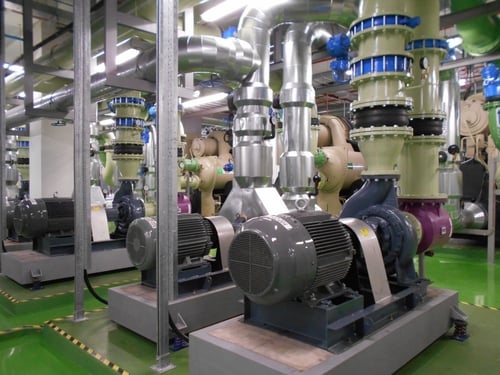Many types of air conditioning cool the air through direct contact with the refrigerant lines. However, this system configuration can be difficult to install in large buildings, especially tall buildings. When water is used as a heat exchange fluid between indoor air and refrigerant, heat can be removed effectively even if conditioned spaces are far from refrigeration equipment.
Without the use of chilled water, there would only be two possible configurations for room cooling:
- Installation of long refrigerant lines between refrigeration equipment and conditioned spaces.
- Air circulation through cooling units and then air distribution with long duct systems.
Long refrigerant lines are more exposed to physical damage and leaks, and refrigerant loss can be significant if the installation is large. On the other hand, air ducts are very bulky and consume more fan energy as their length increases.
Get a high-performance air conditioning design for your project.
Advantages of space cooling with ice water
Water can transport heat removed from indoor spaces more effectively than air, and hydronic tubes are much more compact than air ducts . These drastic differences in the system configuration are due to the physical properties of each substance:
- The specific heat of water is 4.187 kJ/kg-K, while the specific heat of air is 1 kJ/kg-K. In other words, if equivalent masses of air and water experience the same increase in temperature, the water absorbs four times as much heat.
- Water is also much denser than air, having a density of 1,000 kg/m3, while air has a density of 1,225 kg/m3. Water not only transports more heat per kilogram, but also uses less space than air for a given mass.
The greater specific heat and density of water represent design advantages in chilled water systems. When chilled water is used, internal heat can be removed with a smaller fluid mass and hydronic piping is more compact than air ducts.
Ice water is also more convenient when vertical distances are involved. Water can be pumped vertically without problems, but blowing cold air to upper floors is impractical and inefficient.

For a specified cooling load, a chilled water system typically provides greater efficiency than a duct-only air conditioning system. This can be a significant advantage in commercial buildings, where extra efficiency yields thousands of dollars in monthly savings.
How Chilled Water Systems Contribute to Indoor Air Quality
When a building uses only air ducts, the internal areas are interconnected. With this configuration, air pollutants and unpleasant odors can easily spread to other parts of the building. On the other hand, a chilled water system allows the use of a separate air treatment system for each area, isolating pollutants and odors from the air. If one area has air quality issues, areas with separate duct systems will not be affected.
Chilled water systems also produce less noise than air ducts, which improves occupant comfort. This is a significant advantage in office buildings, where constant noise and vibration from an air duct system can be distracting and decrease productivity.
Increasing the performance of chilled water systems
Although chilled water systems are efficient, their energy consumption is still significant. However, there are several possible upgrades that make chilled water systems even more efficient:
- NEMA premium efficiency motors are highly recommended for chilled water pumps and air handlers. These engines have the highest efficiency rating in the US.
- For applications where the load is less than one horsepower, electronically commutated motors (ECM) are recommended. The NEMA Premium Efficiency rating does not cover fractional horsepower motors
- High-efficiency motors can be supplemented with variable frequency drives (VFD), which reduce motor speed during part-load conditions.
- Consider that ECMs already have speed control built in and therefore a VFD is not necessary.
Chilled water systems can typically be integrated with building automation platforms, which optimize their operation based on the current cooling load. Even when a chilled water system uses efficient equipment, superior performance can only be achieved with the correct set points for operation.
Mechanical installations are bulky and poor design decisions can cause a significant increase in the cost of the system. For example, oversized equipment and inefficient duct layouts increase costs without providing benefits. Professional MEP engineers can optimize the cost of chilled water systems while integrating energy efficiency measures such as motor speed control.

